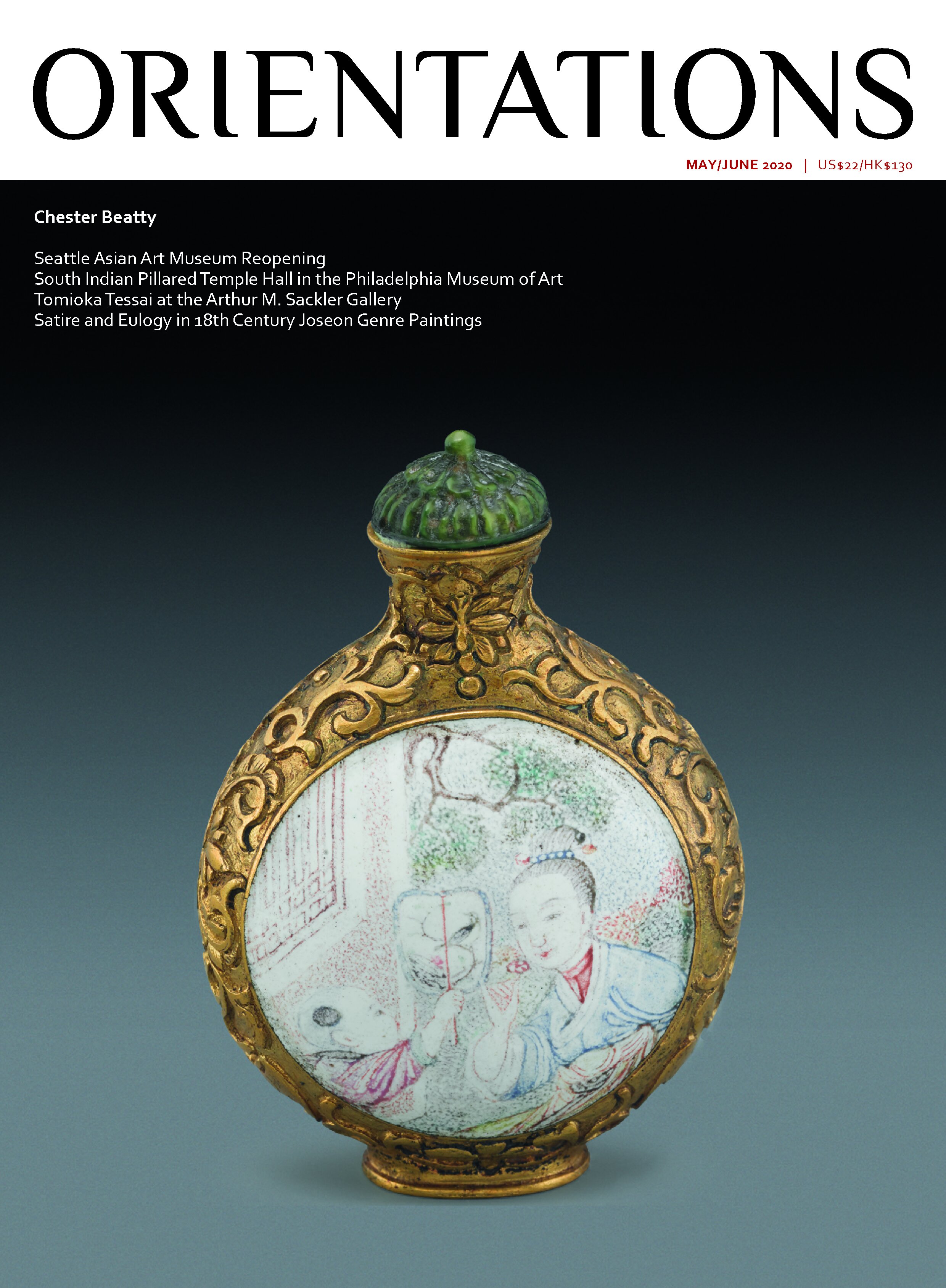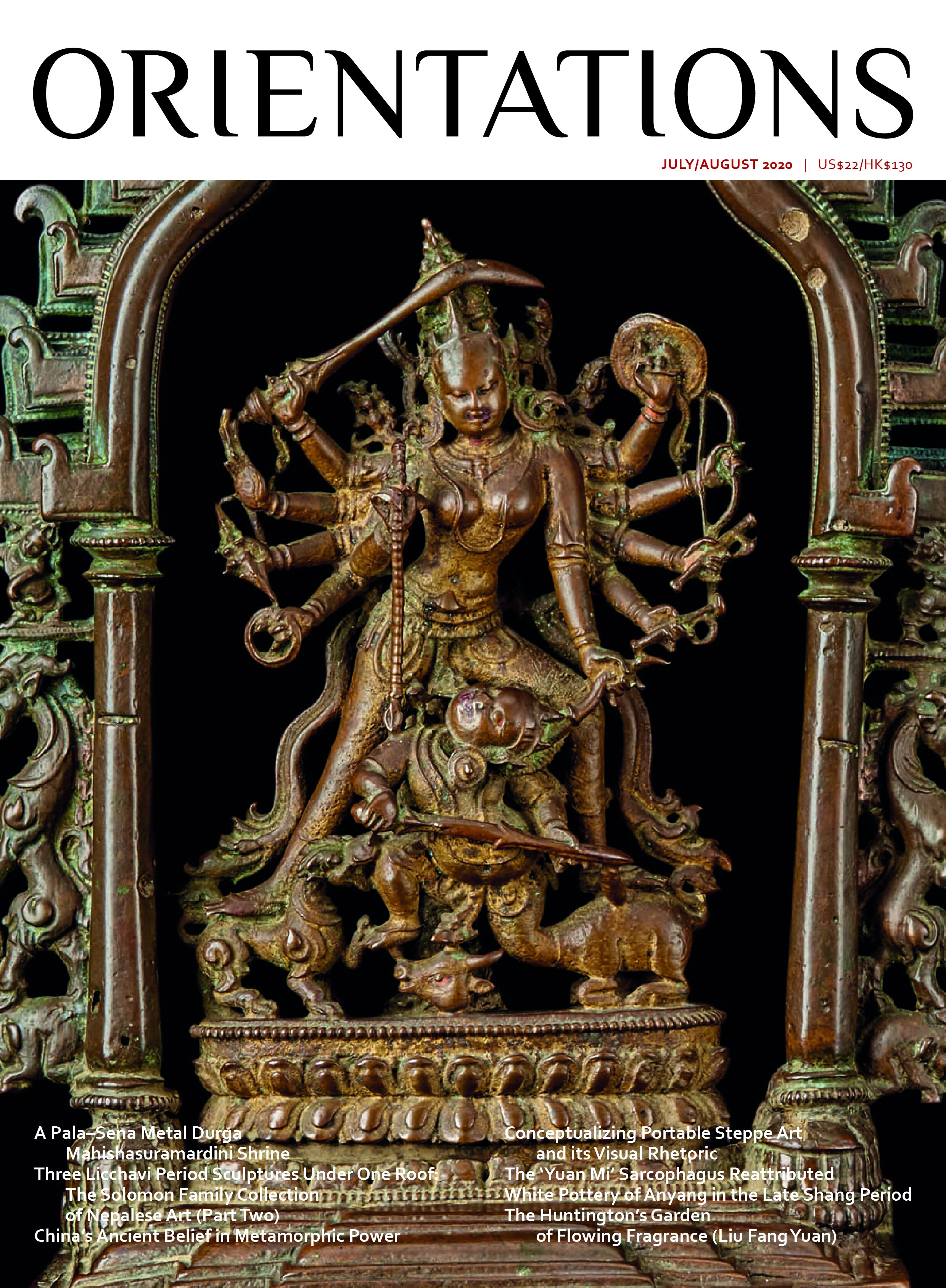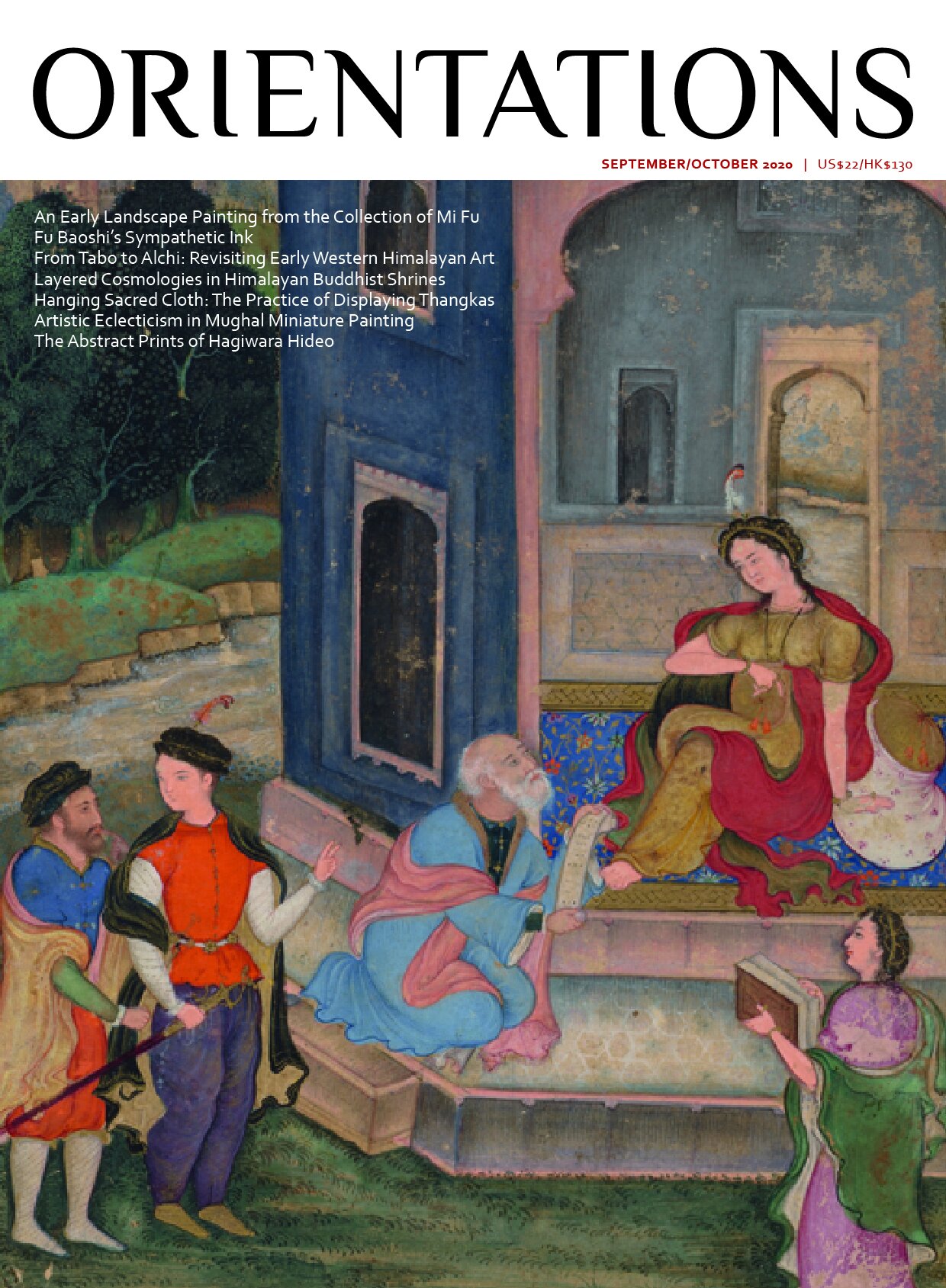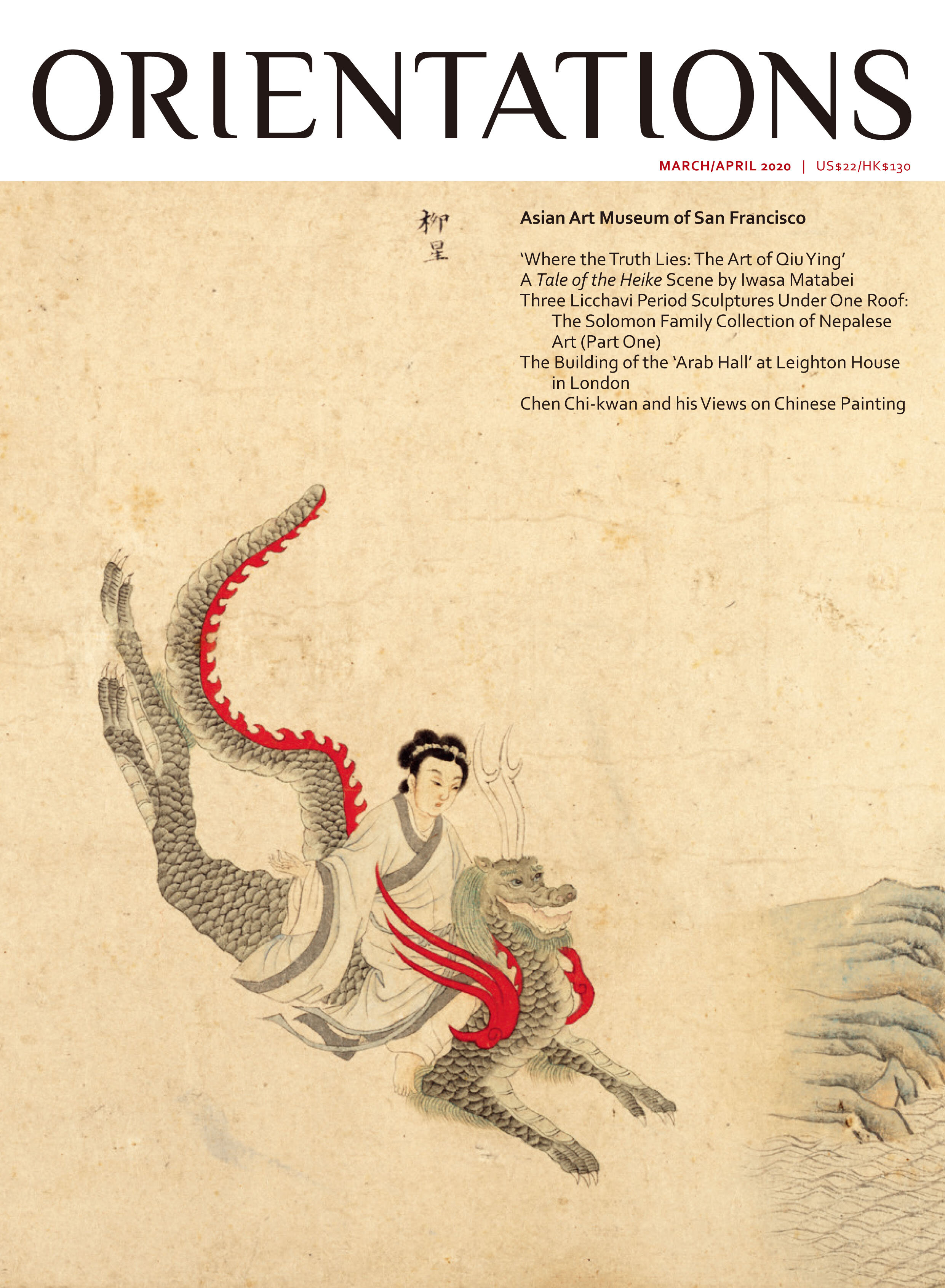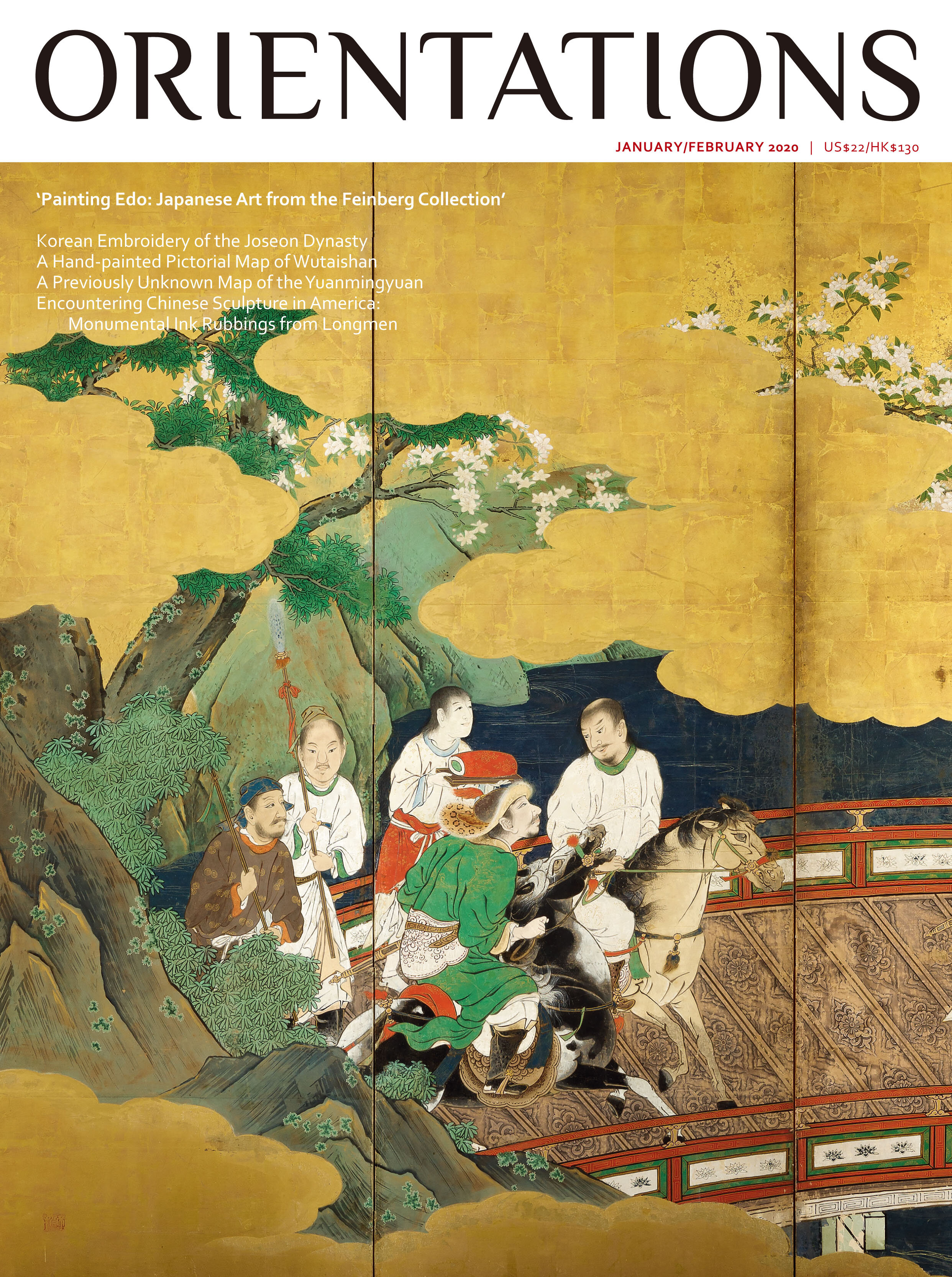MAY/JUN 2020
VOLUME 51 - NUMBER 3
We are all undoubtedly dealing with change during this challenging and disruptive time, and the impact of social distancing and isolation. As art institutions worldwide have closed or face an uncertain future, we are reminded of the value they bring to our lives. Both museums and galleries are finding creative ways to stay connected with their audiences, from ‘The Rubin Daily Offering’ video series by The Rubin Museum of Art to ART Power HK, a collaborative and community-driven website that enables stakeholders in Hong Kong to post features and events online. At Orientations, we have also been exploring ways to remain connected with our readers, and so have worked towards releasing this May/June 2020 issue as our very first digital edition in addition to the print version. We are grateful to the museums and authors featured in this issue for making this possible.
The theme of this issue is the philanthropic activities of individuals around the world. We open with three articles on the Chester Beatty in Ireland. I first went to Dublin in 2018 for the specific purpose of visiting this renowned library and collection. Sir Alfred Chester Beatty (1875–1968), a mining magnate originally from New York, was a discerning collector of European and Persian manuscripts, as well as Chinese snuff bottles and Japanese netsuke. The museum he founded in Dublin in 1953 in his adopted home is today one of Ireland’s favourite National Cultural Institutions and holds an extraordinary collection of over 25,000 works.
We follow with a feature on the Seattle Asian Art Museum, part of the Seattle Art Museum, which was founded in 1933 as a gift to the city by Asian art collector Richard E. Fuller (1897–1976) together with his mother, Margaret E. MacTavish Fuller (1860– 1953). The Asian Art Museum reopened this February after extensive modernization and reinstallation of its historic facility. Instead of focusing on specific countries—China, Japan, Korea and India—the new curatorial direction explores particular themes by juxtaposing artworks from across the Asian continent in a series of interrelated galleries.
Also based in Seattle are Mary and Cheney Cowles, who have amassed one of the largest private collections of Japanese paintings and calligraphy in the West, spanning the 8th century to the present day. Cheney Cowles was the founder of the Crane Gallery, which specialized in Asian antiques. The couple are gifting more than 550 works to three institutions: the Portland Art Museum in Oregon, The Metropolitan Museum of Art in New York and the Freer and Sackler Galleries – Smithsonian Institution in Washington, DC. The exhibition ‘Meeting Tessai: Modern Japanese Art from the Cowles Collection’ (originally scheduled from 28 March to 2 August this year but now delayed) will be the first of two shows at the Freer|Sackler highlighting the transformative gift of over 260 works.
In autumn 1919, 64 immense granite blocks carved with deities, humans, lions, leaves and lotus blossoms and originating from Madana Gopala Swamy Temple, a 16th century building complex in the south Indian city of Madurai, were unpacked and laid out on the lawn in front of Memorial Hall in Philadelphia’s Fairmont Park, the first home of the Philadelphia Museum of Art. The architectural elements had been purchased in 1912 by Adeline Pepper Gibson of Philadelphia while on a visit to Madurai, and were gifted to the museum by her family after her death. It is thus that visitors can see such a structure, one of the few if not the only one of its kind standing outside India.
FEATURES
Fionnuala Croke. A ‘Prince among Benefactors’: Chester Beatty’s Legacy
Mary Redfern. ‘Edo in Colour: Prints from Japan’s Metropolis’
Moya Carey. The ‘Greatest of all Bibliophiles’: Baysunghur in the Collection of Chester Beatty
Foong Ping, Xiaojin Wu and Darielle Mason. An Asian Art Museum Transformed
Darielle Mason. The Philadelphia Museum of Art’s South Indian Pillared Temple Hall Turns 100
Frank Feltens. Meeting Tessai: Works by Tomioka Tessai from the Mary and Cheney Cowles Collection
Mia Y. Ma. and Commoners: Satire and Eulogy in 18th Century Joseon Genre Paintings
REVIEWS
Tushara Bindu Gude. Arts of South Asia: Cultures of Collecting edited by Allysa B. Peyton and Katherine Anne Paul
CURATOR’S CHOICE
Daisy Yiyou Wang. A Journey of Discovery and Friendship
VOLUME 51 - NUMBER 3
We are all undoubtedly dealing with change during this challenging and disruptive time, and the impact of social distancing and isolation. As art institutions worldwide have closed or face an uncertain future, we are reminded of the value they bring to our lives. Both museums and galleries are finding creative ways to stay connected with their audiences, from ‘The Rubin Daily Offering’ video series by The Rubin Museum of Art to ART Power HK, a collaborative and community-driven website that enables stakeholders in Hong Kong to post features and events online. At Orientations, we have also been exploring ways to remain connected with our readers, and so have worked towards releasing this May/June 2020 issue as our very first digital edition in addition to the print version. We are grateful to the museums and authors featured in this issue for making this possible.
The theme of this issue is the philanthropic activities of individuals around the world. We open with three articles on the Chester Beatty in Ireland. I first went to Dublin in 2018 for the specific purpose of visiting this renowned library and collection. Sir Alfred Chester Beatty (1875–1968), a mining magnate originally from New York, was a discerning collector of European and Persian manuscripts, as well as Chinese snuff bottles and Japanese netsuke. The museum he founded in Dublin in 1953 in his adopted home is today one of Ireland’s favourite National Cultural Institutions and holds an extraordinary collection of over 25,000 works.
We follow with a feature on the Seattle Asian Art Museum, part of the Seattle Art Museum, which was founded in 1933 as a gift to the city by Asian art collector Richard E. Fuller (1897–1976) together with his mother, Margaret E. MacTavish Fuller (1860– 1953). The Asian Art Museum reopened this February after extensive modernization and reinstallation of its historic facility. Instead of focusing on specific countries—China, Japan, Korea and India—the new curatorial direction explores particular themes by juxtaposing artworks from across the Asian continent in a series of interrelated galleries.
Also based in Seattle are Mary and Cheney Cowles, who have amassed one of the largest private collections of Japanese paintings and calligraphy in the West, spanning the 8th century to the present day. Cheney Cowles was the founder of the Crane Gallery, which specialized in Asian antiques. The couple are gifting more than 550 works to three institutions: the Portland Art Museum in Oregon, The Metropolitan Museum of Art in New York and the Freer and Sackler Galleries – Smithsonian Institution in Washington, DC. The exhibition ‘Meeting Tessai: Modern Japanese Art from the Cowles Collection’ (originally scheduled from 28 March to 2 August this year but now delayed) will be the first of two shows at the Freer|Sackler highlighting the transformative gift of over 260 works.
In autumn 1919, 64 immense granite blocks carved with deities, humans, lions, leaves and lotus blossoms and originating from Madana Gopala Swamy Temple, a 16th century building complex in the south Indian city of Madurai, were unpacked and laid out on the lawn in front of Memorial Hall in Philadelphia’s Fairmont Park, the first home of the Philadelphia Museum of Art. The architectural elements had been purchased in 1912 by Adeline Pepper Gibson of Philadelphia while on a visit to Madurai, and were gifted to the museum by her family after her death. It is thus that visitors can see such a structure, one of the few if not the only one of its kind standing outside India.
FEATURES
Fionnuala Croke. A ‘Prince among Benefactors’: Chester Beatty’s Legacy
Mary Redfern. ‘Edo in Colour: Prints from Japan’s Metropolis’
Moya Carey. The ‘Greatest of all Bibliophiles’: Baysunghur in the Collection of Chester Beatty
Foong Ping, Xiaojin Wu and Darielle Mason. An Asian Art Museum Transformed
Darielle Mason. The Philadelphia Museum of Art’s South Indian Pillared Temple Hall Turns 100
Frank Feltens. Meeting Tessai: Works by Tomioka Tessai from the Mary and Cheney Cowles Collection
Mia Y. Ma. and Commoners: Satire and Eulogy in 18th Century Joseon Genre Paintings
REVIEWS
Tushara Bindu Gude. Arts of South Asia: Cultures of Collecting edited by Allysa B. Peyton and Katherine Anne Paul
CURATOR’S CHOICE
Daisy Yiyou Wang. A Journey of Discovery and Friendship
VOLUME 51 - NUMBER 3
We are all undoubtedly dealing with change during this challenging and disruptive time, and the impact of social distancing and isolation. As art institutions worldwide have closed or face an uncertain future, we are reminded of the value they bring to our lives. Both museums and galleries are finding creative ways to stay connected with their audiences, from ‘The Rubin Daily Offering’ video series by The Rubin Museum of Art to ART Power HK, a collaborative and community-driven website that enables stakeholders in Hong Kong to post features and events online. At Orientations, we have also been exploring ways to remain connected with our readers, and so have worked towards releasing this May/June 2020 issue as our very first digital edition in addition to the print version. We are grateful to the museums and authors featured in this issue for making this possible.
The theme of this issue is the philanthropic activities of individuals around the world. We open with three articles on the Chester Beatty in Ireland. I first went to Dublin in 2018 for the specific purpose of visiting this renowned library and collection. Sir Alfred Chester Beatty (1875–1968), a mining magnate originally from New York, was a discerning collector of European and Persian manuscripts, as well as Chinese snuff bottles and Japanese netsuke. The museum he founded in Dublin in 1953 in his adopted home is today one of Ireland’s favourite National Cultural Institutions and holds an extraordinary collection of over 25,000 works.
We follow with a feature on the Seattle Asian Art Museum, part of the Seattle Art Museum, which was founded in 1933 as a gift to the city by Asian art collector Richard E. Fuller (1897–1976) together with his mother, Margaret E. MacTavish Fuller (1860– 1953). The Asian Art Museum reopened this February after extensive modernization and reinstallation of its historic facility. Instead of focusing on specific countries—China, Japan, Korea and India—the new curatorial direction explores particular themes by juxtaposing artworks from across the Asian continent in a series of interrelated galleries.
Also based in Seattle are Mary and Cheney Cowles, who have amassed one of the largest private collections of Japanese paintings and calligraphy in the West, spanning the 8th century to the present day. Cheney Cowles was the founder of the Crane Gallery, which specialized in Asian antiques. The couple are gifting more than 550 works to three institutions: the Portland Art Museum in Oregon, The Metropolitan Museum of Art in New York and the Freer and Sackler Galleries – Smithsonian Institution in Washington, DC. The exhibition ‘Meeting Tessai: Modern Japanese Art from the Cowles Collection’ (originally scheduled from 28 March to 2 August this year but now delayed) will be the first of two shows at the Freer|Sackler highlighting the transformative gift of over 260 works.
In autumn 1919, 64 immense granite blocks carved with deities, humans, lions, leaves and lotus blossoms and originating from Madana Gopala Swamy Temple, a 16th century building complex in the south Indian city of Madurai, were unpacked and laid out on the lawn in front of Memorial Hall in Philadelphia’s Fairmont Park, the first home of the Philadelphia Museum of Art. The architectural elements had been purchased in 1912 by Adeline Pepper Gibson of Philadelphia while on a visit to Madurai, and were gifted to the museum by her family after her death. It is thus that visitors can see such a structure, one of the few if not the only one of its kind standing outside India.
FEATURES
Fionnuala Croke. A ‘Prince among Benefactors’: Chester Beatty’s Legacy
Mary Redfern. ‘Edo in Colour: Prints from Japan’s Metropolis’
Moya Carey. The ‘Greatest of all Bibliophiles’: Baysunghur in the Collection of Chester Beatty
Foong Ping, Xiaojin Wu and Darielle Mason. An Asian Art Museum Transformed
Darielle Mason. The Philadelphia Museum of Art’s South Indian Pillared Temple Hall Turns 100
Frank Feltens. Meeting Tessai: Works by Tomioka Tessai from the Mary and Cheney Cowles Collection
Mia Y. Ma. and Commoners: Satire and Eulogy in 18th Century Joseon Genre Paintings
REVIEWS
Tushara Bindu Gude. Arts of South Asia: Cultures of Collecting edited by Allysa B. Peyton and Katherine Anne Paul
CURATOR’S CHOICE
Daisy Yiyou Wang. A Journey of Discovery and Friendship

